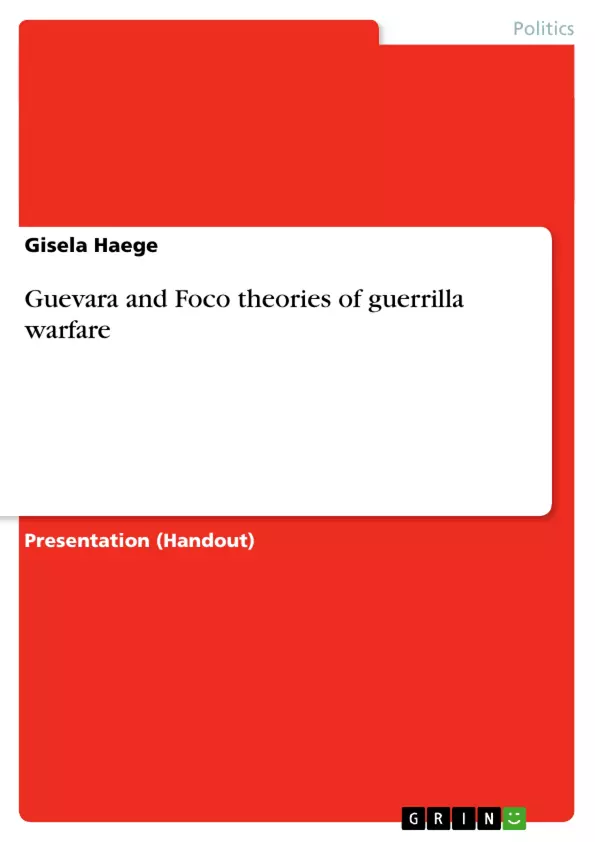Alternative models of insurgency are provided by the doctrine of “people’s war,” “foco theory”, and the urban guerrilla.
Che Guevara
After working with lepers in Peru (He had a medical degree.) and witnessing the CIA-sponsored coup of Guatemala's president in 1954, Guevara met Castro in Mexico City in July, 1956, and four months later joined the 80-strong guerrilla force that would topple Batista on Jan. 1, 1959.
After serving in various high-level government positions (last one: Minister of Industry), Guevara became disillusioned with Soviet involvement in Cuba (Guevara realised that the Soviet Union upon whom isolated Cuba was increasingly dependent, was not much different than the U.S. in its exploitation of the developing world for their own interests. The Russians procured sugar at a favourable price, while discouraging Cuba from developing industrial self-sufficiency and left Cuba in 1965.
He returned to the field, joining an unsuccessful guerrilla campaign in the Congo. In 1967, he went to Bolivia to trigger a peasant-supported revolution across Latin American. Without local help and hounded by the U.S.-assisted Bolivian army, Guevara was captured and killed October 9. (A peasant informed on the rebels. The remaining revolutionaries were outnumbered and surrounded in a valley.
Inhaltsverzeichnis (Table of Contents)
- Guevara and Foco theories of guerrilla warfare
- Cuban revolution (1952-1958)
- Foco theory
- Stages of guerrilla warfare
- Foco
Zielsetzung und Themenschwerpunkte (Objectives and Key Themes)
This text explores the theories of guerrilla warfare developed by Che Guevara and the concept of “foco” as alternative models of insurgency. It examines the Cuban Revolution as a historical example of guerrilla warfare and analyzes the key elements of the foco theory, including its strategies, tactics, and characteristics.
- Alternative models of insurgency, including “people’s war” and “foco theory”
- Che Guevara’s experiences and contributions to guerrilla warfare
- The Cuban Revolution as a case study for guerrilla warfare
- Key principles and characteristics of the foco theory
- The role of rural areas and the peasantry in guerrilla warfare
Zusammenfassung der Kapitel (Chapter Summaries)
- Guevara and Foco theories of guerrilla warfare: Introduces the concept of “foco” as an alternative model of insurgency and explores its relationship to Guevara’s theories of guerrilla warfare.
- Cuban revolution (1952-1958): Provides a detailed account of the Cuban Revolution, highlighting its key events, actors, and the role of guerrilla tactics in its success.
- Foco theory: Examines the main principles and characteristics of the foco theory, including its focus on rural areas, the importance of a small, dedicated vanguard, and strategies for demoralizing the enemy and empowering the populace.
- Stages of guerrilla warfare: Describes the stages of guerrilla warfare according to foco theory, emphasizing the establishment of liberated zones, the development of infrastructure, and the ultimate goal of a revolutionary offensive.
- Foco: Defines the term “foco” in the context of guerrilla warfare, emphasizing its political-military organization, its role as the nucleus of a popular army, and its strategic significance in initiating and driving a revolutionary movement.
Schlüsselwörter (Keywords)
Key terms and topics explored in this text include guerrilla warfare, foco theory, Cuban Revolution, Che Guevara, rural areas, peasant populations, revolutionary movements, strategies, tactics, liberated zones, political leadership, and armed struggle.
- Quote paper
- Gisela Haege (Author), 2002, Guevara and Foco theories of guerrilla warfare, Munich, GRIN Verlag, https://www.grin.com/document/16122



